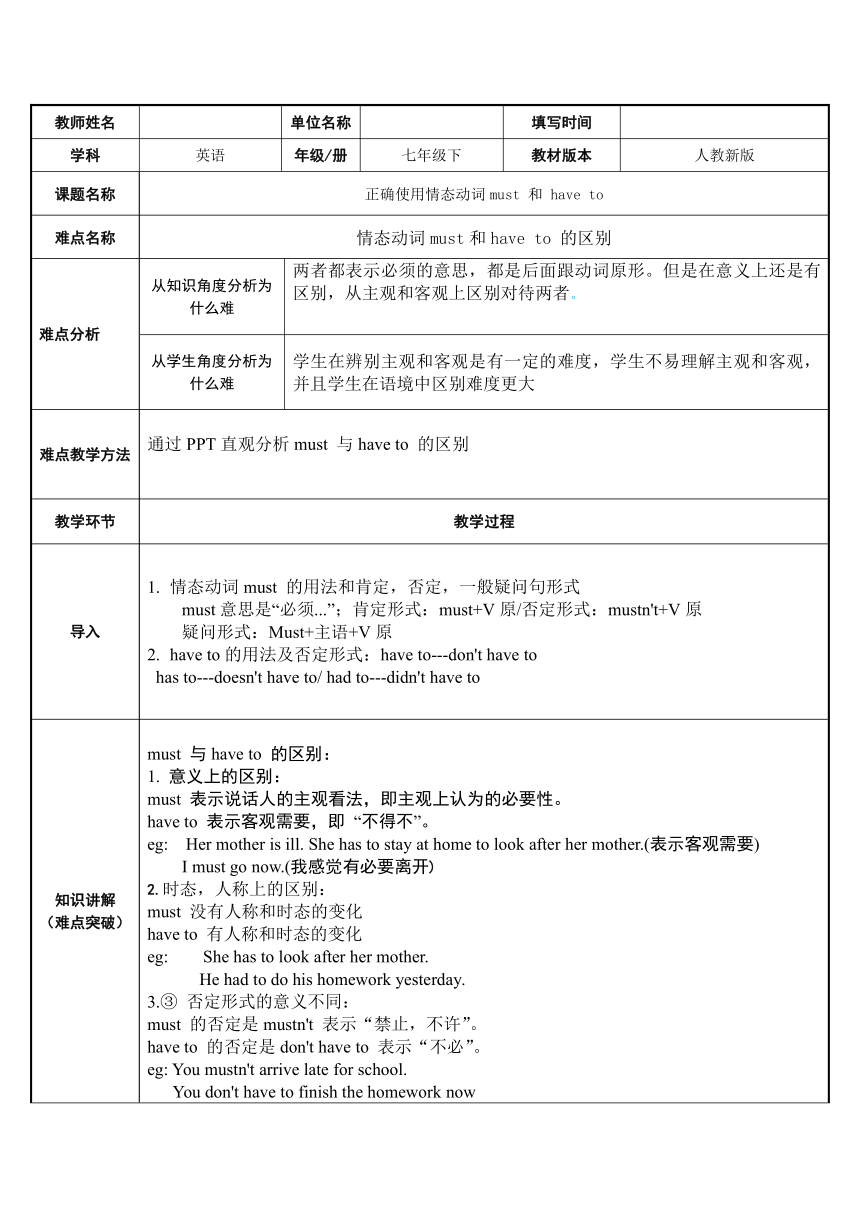Unit 4 Don't eat in class. 正确使用情态动词 must和have to 教案
文档属性
| 名称 | Unit 4 Don't eat in class. 正确使用情态动词 must和have to 教案 |  | |
| 格式 | docx | ||
| 文件大小 | 16.5KB | ||
| 资源类型 | 教案 | ||
| 版本资源 | 人教新目标(Go for it)版 | ||
| 科目 | 英语 | ||
| 更新时间 | 2022-03-21 22:40:24 | ||
图片预览

文档简介
教师姓名 单位名称 填写时间
学科 英语 年级/册 七年级下 教材版本 人教新版
课题名称 正确使用情态动词must 和 have to
难点名称 情态动词must和have to 的区别
难点分析 从知识角度分析为什么难 两者都表示必须的意思,都是后面跟动词原形。但是在意义上还是有区别,从主观和客观上区别对待两者。
从学生角度分析为什么难 学生在辨别主观和客观是有一定的难度,学生不易理解主观和客观,并且学生在语境中区别难度更大
难点教学方法 通过PPT直观分析must 与have to 的区别
教学环节 教学过程
导入 情态动词must 的用法和肯定,否定,一般疑问句形式 must意思是“必须...”;肯定形式:must+V原/否定形式:mustn't+V原 疑问形式:Must+主语+V原 have to的用法及否定形式:have to---don't have to has to---doesn't have to/ had to---didn't have to
知识讲解 (难点突破) must 与have to 的区别: 意义上的区别: must 表示说话人的主观看法,即主观上认为的必要性。 have to 表示客观需要,即 “不得不”。 eg: Her mother is ill. She has to stay at home to look after her mother.(表示客观需要) I must go now.(我感觉有必要离开) 2.时态,人称上的区别: must 没有人称和时态的变化 have to 有人称和时态的变化 eg: She has to look after her mother. He had to do his homework yesterday. 3.③ 否定形式的意义不同: must 的否定是mustn't 表示“禁止,不许”。 have to 的否定是don't have to 表示“不必”。 eg: You mustn't arrive late for school. You don't have to finish the homework now 用must 提问的句子,肯定回答用must,而否定回答则用needn't或者don't have to. 表示“不必”。 eg: --Must I come at four o'clock --Yes,you must. --No, you needn't / you don't have to.
课堂练习 (难点巩固) 一.请用must 或have to的适当形式填空。 1. I'll ____________ look after my sister at home this Sunday. 2. We__________follow the school rules. 3. I got up late this morning, so I___________take a taxi to school. 4. ---Must I get to the station before five o'clock ---Yes, you__________. ---No, you________________
小结 通过对must和have to的用法讲解,学生能够辨析两者的用法。
学科 英语 年级/册 七年级下 教材版本 人教新版
课题名称 正确使用情态动词must 和 have to
难点名称 情态动词must和have to 的区别
难点分析 从知识角度分析为什么难 两者都表示必须的意思,都是后面跟动词原形。但是在意义上还是有区别,从主观和客观上区别对待两者。
从学生角度分析为什么难 学生在辨别主观和客观是有一定的难度,学生不易理解主观和客观,并且学生在语境中区别难度更大
难点教学方法 通过PPT直观分析must 与have to 的区别
教学环节 教学过程
导入 情态动词must 的用法和肯定,否定,一般疑问句形式 must意思是“必须...”;肯定形式:must+V原/否定形式:mustn't+V原 疑问形式:Must+主语+V原 have to的用法及否定形式:have to---don't have to has to---doesn't have to/ had to---didn't have to
知识讲解 (难点突破) must 与have to 的区别: 意义上的区别: must 表示说话人的主观看法,即主观上认为的必要性。 have to 表示客观需要,即 “不得不”。 eg: Her mother is ill. She has to stay at home to look after her mother.(表示客观需要) I must go now.(我感觉有必要离开) 2.时态,人称上的区别: must 没有人称和时态的变化 have to 有人称和时态的变化 eg: She has to look after her mother. He had to do his homework yesterday. 3.③ 否定形式的意义不同: must 的否定是mustn't 表示“禁止,不许”。 have to 的否定是don't have to 表示“不必”。 eg: You mustn't arrive late for school. You don't have to finish the homework now 用must 提问的句子,肯定回答用must,而否定回答则用needn't或者don't have to. 表示“不必”。 eg: --Must I come at four o'clock --Yes,you must. --No, you needn't / you don't have to.
课堂练习 (难点巩固) 一.请用must 或have to的适当形式填空。 1. I'll ____________ look after my sister at home this Sunday. 2. We__________follow the school rules. 3. I got up late this morning, so I___________take a taxi to school. 4. ---Must I get to the station before five o'clock ---Yes, you__________. ---No, you________________
小结 通过对must和have to的用法讲解,学生能够辨析两者的用法。
同课章节目录
- Unit 1 Can you play the guitar?
- Section A
- Section B
- Unit 2 What time do you go to school?
- Section A
- Section B
- Unit 3 How do you get to school?
- Section A
- Section B
- Unit 4 Don't eat in class.
- Section A
- Section B
- Unit 5 Why do you like pandas?
- Section A
- Section B
- Unit 6 I'm watching TV.
- Section A
- Section B
- Review of Units 1-6
- Unit 7 It's raining!
- Section A
- Section B
- Unit 8 Is there a post office near here?
- Section A
- Section B
- Unit 9 What does he look like?
- Section A
- Section B
- Unit 10 I'd like some noodles.
- Section A
- Section B
- Unit 11 How was your school trip?
- Section A
- Section B
- Unit 12 What did you do last weekend?
- Section A
- Section B
